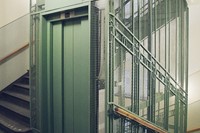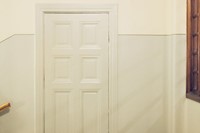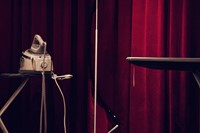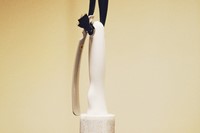Last week, amidst ice covered lakes and snowy landscapes, Stockholm saw the return of its biannual fashion week. Shows took place in a series of obscure and historic locations, from the gymnasium of a former 1960s sewing school...
Last week, amidst ice covered lakes and snowy landscapes, Stockholm saw the return of its biannual fashion week. Shows took place in a series of obscure and historic locations, from the gymnasium of a former 1960s sewing school to the grand nineteenth century rooms of Berns Hotel. During the three-day event, AnOther invited photographer Erika Svensson to capture backstage details at the shows, and here we take a closer look at this season's artistic references and how Stockholm's public spaces reverberated through the collections.
Stockholm City Library, a 1920s building designed by architect Erik Gunnar Asplund, became a strong reference for the J.Lindenberg show, which was appropriately named Modernist Elegance. Architectural elements from the building's stairwells and large windows were referenced in the collection's oversized and a-line silhouettes, bringing classical order to more abstract geometric forms, whilst the rich colour palette of deep plums, reds and a classic 'library' green were taken from internal decorative elements.
Cheap Monday showcased their Artificial Grunge collection inside the industrial shell of the former gymnasium of a all-girls school. Originally designed during the 1960s, its architectural style was inspired Le Corbusier's housing design, Unité d'Habitation. The collection itself played with texture and layering, shredded denim was worn alongside sheer lace, and neon yellow with metallic details. Models emerged wearing blunt plum and orange fringes, braids and adorned with icy blue make-up.
"Stockholm City Library became a strong reference for the J.Lindenberg show...with architectural elements from the building's stairwells and large windows referenced in the collection"
Moving away from Modernism, the elaborate grand hall of Berns Hotel became home to the majority of the shows this season. Alongside Stockholm's more established designers, Beckmans College of Design, an institution established in 1939, showcased fourteen of its second year students in the building. Malin Unga referenced her own Sami heritage, the only indigenous community of Scandinavia. “My grandmother and grandfather are Sami, so I wanted to do my own take on the nomadic lifestyle, where you carry your home on your back,” she explained backstage. “I have tried to capture a philosophy of living and wearing your clothes.” This translated in her use of traditional materials, where fabrics were deconstructed and bound to create voluminous shapes. Unga also constructed crown headpieces from cloth, a homage to the ones her grandmother used to make for dolls and covered her designs with several ornaments.
Dagmar took a similar approach to decorating the body, when they painted black horizontal stripes down their models slicked back hair. The repetition of this design suggested a tribal or animalistic element to the collection, which featured tailored military coats with leather detail and sheepskin jackets.
In the final show of the week, Tiger of Sweden examined the architectural style of Bauhaus and boundaries between functionality and art. Colour blocking, particularly with a series of bold pinks and oranges, became a reference to its modernist interiors. Emphasis was placed on straight lines and tailored silhouettes, offering a utilitarian approach to structuring fabrics around the body. Metallics were also introduced and ran alongside dark greys and bold yellows.
Text by Isabella Burley






